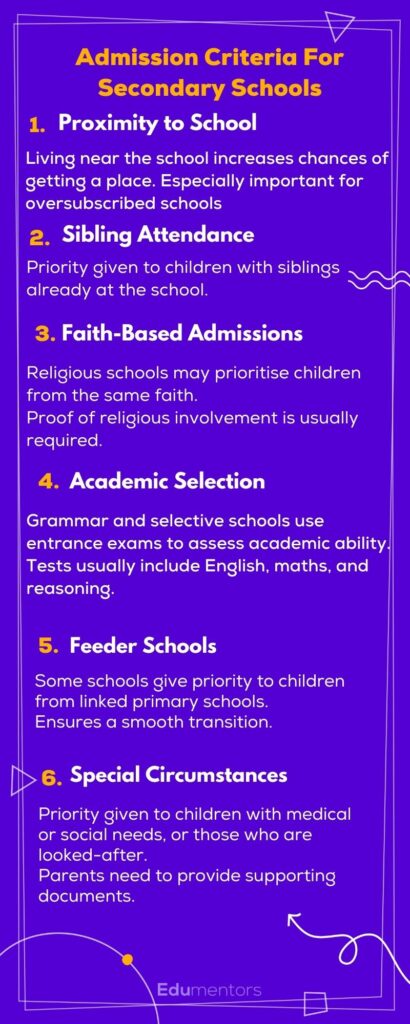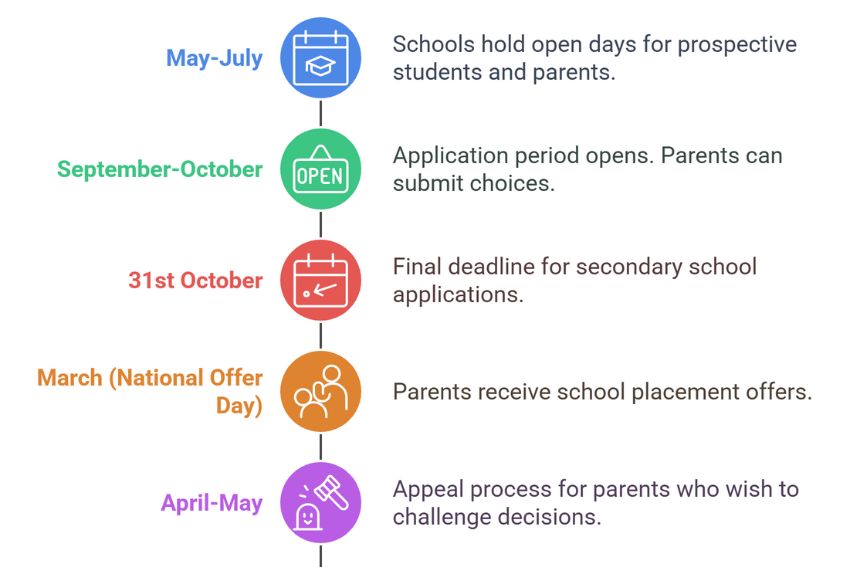Understanding the admission criteria for secondary schools is key to securing the right place for your child. With different schools using different entry requirements, knowing what to expect can help you plan ahead and improve your child’s chances of getting in.
Not all schools use the same criteria. Some prioritise children who live in the catchment area, while others consider sibling policies, entrance exams, or religious affiliation. Grammar schools and independent schools often have selective entry requirements, while community schools follow local authority guidelines.
Since each secondary school admissions process is different, it’s important to check the requirements early. In this guide, we’ll break down what you need to know about secondary school places in the UK and how to navigate the application process.
Common Admission Criteria For Secondary Schools
Since you already have an idea of how each secondary school has its own set of rules for deciding who gets a place, it’s important to understand the key factors. Understanding these criteria can help you make the best school choices for your child. Let’s explore the most common ones that influence secondary school admissions and how they might affect your application.

Types of Secondary Schools and Their Admission Policies
Now that we’ve covered the admission criteria for secondary schools, it’s important to understand how different types of secondary schools set their admission policies. While some follow local authority guidelines, others have independent selection processes. Let’s look at how admissions work across different school types.
Community Schools: Local Authority Admissions
Community schools are state-funded and run by the local authority. They do not select students based on ability and follow standard admission rules, such as catchment areas, sibling priority, and feeder school links. If there are more applicants than places available, the local authority decides who gets in based on priority categories. Main point is that admissions are handled by your local council, so applications must be submitted through their official process.
Academies and Free Schools: Independent Admissions Policies
Academies and free schools are also state-funded but independently run, meaning they do not have to follow local authority admission rules. Instead, each academy or free school sets its own admissions criteria, which can vary widely. Some academies and free schools follow standard catchment-based admissions, while others may:
- Prioritise certain subjects (e.g. specialist STEM or performing arts schools).
- Have their own selection process, including aptitude tests.
- Offer places based on religious affiliation (for faith-based academies).
Key point: Always check individual school policies, as criteria may differ significantly from community schools.
Voluntary-Aided and Faith Schools
Voluntary-aided schools, often linked to religious organisations, have more control over their admissions. Faith-based schools, such as Catholic, Church of England, and Jewish schools, may give priority to children who follow their religious beliefs. Admission requirements might include:
- A baptism certificate or proof of religious commitment.
- A letter from a place of worship confirming attendance.
- Preference given to families actively involved in the religious community.
If you’re applying to a faith school, check their admissions criteria early and make sure that you meet any requirements.
Grammar Schools: Selective Admissions and Entrance Exams
Grammar schools and selective secondary schools admit students based on academic ability. Entry is usually determined by the 11 Plus exam, which tests:
- English
- Maths
- Verbal and non-verbal reasoning
Some independent schools also require entrance exams and interviews. Since competition is high, many parents prepare their children through private tutoring or structured revision courses.
Independent Schools: Private Admissions Processes
Independent (private) schools operate outside of government funding and set their own admissions criteria. Entry often involves:
- Entrance exams testing English, maths, and reasoning skills.
- Interviews to assess a child’s personality, interests, and suitability.
- School reports and references from previous schools.
Since private schools are not bound by local authority rules, they can be more flexible in their admissions but also more competitive. Many families apply years in advance to secure a place.
Key Point: Private school admissions vary widely, so visiting open days and applying early can improve your chances.
How to Apply for Secondary School
Since you already understand the admission criteria for secondary schools, the next step is navigating the application process. Applying on time and providing the correct information is important to securing a place at your preferred school. Here’s what you need to know.
Dates and Deadlines
Most secondary school applications in the UK follow a set timeline. Local authorities and schools announce their key dates in advance, so you need to stay informed.
Typical Application Timeline

Tip: Some schools have additional selection tests (like the 11 Plus for grammar schools), which may have separate deadlines. Always check early!
How to Apply
| State Schools | Grammar Schools | Private Schools |
| Apply via your local authority’s online portal. | Register for the 11 Plus entrance exam separately,usually in June-July before Year 6. | Apply directly to the school. |
| List preferred schools in order of priority (usually up to 6 choices). | Apply through the local authority (for most grammar schools). | Entry may involve exams, interviews, and references. |
| Submit before 31st October. | Some selective schools require direct applications. | Deadlines vary, but applications are often due in autumn or early winter. |
Supporting Documents
To complete your application, you may need to submit these documents:
- Birth certificate – Proof of age and identity.
- Proof of address – Utility bills, council tax statement, or tenancy agreement.
- Academic records – For selective schools and transfers.
- Religious affiliation proof – Required for faith-based schools (e.g. baptism certificate).
- Medical or social reports – If applying under special circumstances.
Applying for a secondary school place can feel overwhelming. Staying organised and meeting deadlines will make the process easier. Next, we’ll look into some tips to help you choose the best school for your child.
Admission Criteria For Secondary Schools : Tips for Parents
Wondering how to support your child during this important transition? Choosing the right secondary school isn’t just about submitting an application, it’s about making an informed decision and preparing your child for success. One helpful step is to review the Ofsted inspection framework to better understand how schools are evaluated. Here are some additional tips to help you along the way.y.
Researching Schools: Find the Best Fit
Before applying, take the time to research your options thoroughly. Every school has a different approach to learning, so finding one that suits your child’s needs is a must.
- Attend open days: Visit schools, meet teachers, and get a feel for the learning environment.
- Check Ofsted reports: These provide insights into a school’s academic performance and teaching quality.
- Talk to other parents: Hearing from families with children already in the school can give you a real perspective.
- Consider travel distance: Make sure the school is practical for your daily routine.
Preparing Your Child: Getting Ready for the Transition
Whether your child is applying for a non-selective school or facing an entrance exam or interview, preparation is important.
- Grammar and selective schools: Help your child practise for the 11 Plus or entrance exams by using sample papers and revision guides.
- Independent schools: Prepare for interviews by encouraging your child to talk about their interests, strengths, and achievements.
- All schools: Make sure your child is emotionally ready for the transition by discussing any concerns and familiarising them with the new school environment.
Tip: If your child is taking an entrance exam, start preparing months in advance to avoid last-minute stress.
Staying Informed: Keep Up with Changes
School admission policies can change every year, so staying informed is essential. Check school websites regularly for updates on admission rules, catchment areas, and deadlines, as these can shift unexpectedly. Many local authorities offer email alerts, so signing up can help you stay ahead of any changes. It’s also useful to follow education news, as government policies can sometimes impact school admissions. Lastly, a tip for you is that don’t assume that last year’s criteria will be the same, always double-check before applying.
Conclusion
Applying for a secondary school place can feel overwhelming, but understanding the admission criteria for secondary schools makes the process much easier. As you already know, each school follows different rules. So, first you need to have a understanding of these.
As policies and deadlines can change, parents should research schools early, attend open days, and keep track of important dates. For those preparing for grammar school entrance exams or independent school interviews, online tutoring can provide structured support, helping students build confidence and improve their chances of success.








